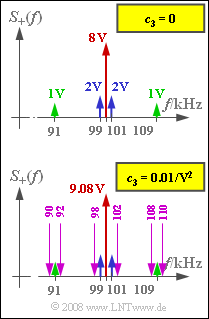Exercise 2.3Z: DSB-AM due to Nonlinearity
In this task, we consider the realization of a double-sideband amplitude modulation using the nonlinear characteristic curve: $$y = g(x) = c_1 \cdot x + c_2 \cdot x^2+ c_3 \cdot x^3\hspace{0.05cm}$$
- $$ \Rightarrow c_1 = 2,\hspace{0.2cm}c_2 = 0.25/{\rm V},\hspace{0.2cm}c_3 = 0 \hspace{0.1cm}{\rm bzw.}\hspace{0.1cm}c_3 = 0.01/{\rm V^2}\hspace{0.05cm}.$$
The sum of the carrier signal and source signal is present at the input of this characteristic curve: $$ x(t) = z(t) + q(t) = A_{\rm T} \cdot \cos(\omega_{\rm T} t)+ q(t),\hspace{0.2cm} A_{\rm T} = 4\,{\rm V}\hspace{0.05cm}.$$
- It is known that the source signal $q(t)$ contains spectral components between $1 \ \rm kHz$ and $9 \ \rm kHz$ (up to and including these limits).
- From subtask (5) onwards, the following source signal should be assumed:
- $$q(t) = A_{\rm 1} \cdot \cos(\omega_{\rm 1} t)+A_{\rm 9} \cdot \cos(\omega_{\rm 9} t) \hspace{0.05cm}.$$
- Let the angular frequencies be $ω_1 = 2 π · 1 \ \rm kHz$ and $ω_9 = 2 π · 9\ \rm kHz$. The corresponding amplitudes are given as: $A_1 = 1\ \rm V$ and $A_9 = 2\ \rm V$.
The following abbreviations are used in the questions for this task:
- $$ y(t) = y_1(t) + y_2(t)+y_3(t),$$
- $$y_1(t) = c_1 \cdot [z(t) + q(t)],$$
- $$ y_2(t) = c_2 \cdot[z(t) + q(t)]^2,$$
- $$y_3(t) = c_3 \cdot [z(t) + q(t)]^3 \hspace{0.05cm}.$$
Thus, the transmitted signals $s(t)$ i.e., $s_1(t)$, $s_2(t)$ and $s_3(t)$ , result from band-limiting to the range from $90 \ \rm kHz$ to $110 \ \rm kHz$.
Hints:
- This exercise belongs to the chapter Double-Sideband Amplitude Modulation.
- Particular reference is made to the page Amplitude modulation with a quadratic characteristic curve.
- The following trigonometric transformations are given:
- $$ \cos^2(\alpha) = {1}/{2} \cdot \left[ 1 + \cos(2\alpha)\right] \hspace{0.05cm}, \hspace{0.5cm} \cos^3(\alpha) = {1}/{4} \cdot \left[ 3 \cdot \cos(\alpha) + \cos(3\alpha)\right] \hspace{0.05cm}.$$
Questions
Solution
- Weicht $f_{\rm T}$ um nicht mehr als $±1 \ \rm kHz$ davon ab, ergibt sich ebenfalls eine „ZSB–AM”.
(2) $s_1(t)$ beinhaltet nur den Träger $z(t)$ ⇒ Antwort 1. Das Quellensignal $q(t)$ wird durch den Bandpass entfernt.
(3) Der quadratische Term $z^2(t)$ besteht aus einem Gleichanteil $($bei $f = 0)$ sowie einem Anteil bei $2f_{\rm T}$.
- Auch alle Spektralanteile von $q^2(t)$ liegen außerhalb des Bandpasses.
- Richtig ist somit die letzte Antwort.
(4) Richtig sind die Lösungsvorschläge 1 und 3:
- Der Term $\cos^3(ω_Tt)$ hat seinen größten Signalanteil bei $f = f_{\rm T}$.
- Der dritte Lösungsvorschlag $(3 · c_3 · z(t) · q^2(t))$ liegt zwischen $100\ \rm kHz ± 18 \ \rm kHz $.
- Teile davon – nämlich die Frequenzanteile zwischen $90\ \rm kHz $ und $110 \ \rm kHz$ – werden durch den Bandpass nicht entfernt und sind somit auch in $s(t)$ enthalten.
(5) Das Sendesignal besteht aus insgesamt fünf Frequenzen:
- $$s(t) = c_1 \cdot A_{\rm T} \cdot \cos(\omega_{\rm T} t)+ c_2 \cdot A_{\rm T} \cdot A_{\rm 1} \cdot \cos((\omega_{\rm T} \pm \omega_{\rm 1})t) + c_2 \cdot A_{\rm T} \cdot A_{\rm 2} \cdot \cos((\omega_{\rm T} \pm \omega_{\rm 2})t) \hspace{0.05cm}.$$
- Beachten Sie hierbei, dass der zweite und dritte Term jeweils zwei Signalfrequenzen beinhaltet:
- $\text{99 kHz}$ und $\text{101 kHz}$ bzw.
- $\text{91 kHz}$ und $\text{109 kHz}$.
- Mit $A_{\rm T} = 4 \ \rm V$, $A_1 = 1 V$, $A_9 = 2 \ \rm V$, $c_1 = 1$ und $c_2 = 1/A_{\rm T} = \rm 0.25/V$ gilt auch:
- $$s(t) = 4\,{\rm V} \cdot \cos(\omega_{\rm T} t) + 1\,{\rm V} \cdot \cos((\omega_{\rm T} \pm \omega_{\rm 1})t) + 2\,{\rm V}\cdot \cos((\omega_{\rm T} \pm \omega_{\rm 2})t) \hspace{0.05cm}.$$
- Daran erkennt man, dass für den Modulationsgrad gilt:
- $$m =\frac{A_1 + A_9}{A_{\rm T}} = \rm \frac{1\ V + 2 \ V}{4 \ V} \hspace{0.15cm}\underline{=0.75}.$$
(6) Die Grafik zeigt oben das Spektrum $S_+(f)$ – also nur positive Frequenzen – mit $c_3 = 0$.
- Mit $c_3 ≠ 0$ fallen folgende zusätzliche Spektralanteile an:
- $$c_3 \cdot z^3(t)= \frac{c_3 \cdot A_{\rm T}^3}{4} \cdot \left[ 3 \cdot \cos(\omega_{\rm T} t) + \cos(3\omega_{\rm T} t)\right] \hspace{0.05cm}.$$
- Der erste Anteil fällt in den Durchlassbereich des Bandpasses. Das Diracgewicht bei $f_{\rm T} = 100\ \rm kHz$ wird dadurch von ursprünglich $8 \ \rm V$ auf $\text{8 V + 0.75 · 0.01/V}^2 · 4^3 \text{ V}^3 = 8.48 \ \rm V$ erhöht.
- Weiterhin liefert der dritte Spektralanteil von Teilaufgabe (4) einen unerwünschten Beitrag zu $S_+(f)$. Dabei gilt:
- $$q^2(t) = \left[A_{\rm 1} \cdot \cos(\omega_{\rm 1} t)+A_{\rm 9} \cdot \cos(\omega_{\rm 9} t)\right]^2 = A_{\rm 1}^2 \cdot \cos^2(\omega_{\rm 1} t)+ A_{\rm 9}^2 \cdot \cos^2(\omega_{\rm 9}t) + 2 \cdot A_{\rm 1} \cdot A_{\rm 9} \cdot \cos(\omega_{\rm 1} t)\cdot \cos(\omega_{\rm 9} t)$$
- $$ \Rightarrow \hspace{0.2cm} q^2(t) = \frac{A_{\rm 1}^2}{2} +\frac{A_{\rm 1}^2}{2} \cdot \cos(\omega_{\rm 2} t)+ \frac{A_{\rm 9}^2}{2} + \frac{A_{\rm 9}^2}{2} \cdot \cos(\omega_{\rm 18} t) + A_{\rm 1} \cdot A_{\rm 9} \cdot \cos(\omega_{\rm 8} t)+ A_{\rm 1} \cdot A_{\rm 9} \cdot \cos(\omega_{\rm 10} t).$$
- Nach der Multiplikation mit $z(t)$ fallen alle diese Beiträge bis auf den vierten in den Bereich von $\text{90 kHz}$ bis $\text{110 kHz}$. Das Gewicht bei $f_{\rm T} = 100\ \rm kHz$ wird um $3 · c_3 · A_{\rm T} · 0.5 (A_1^2 + A_9^2) = 0.6\ \rm V$ weiter erhöht und ist somit $9.08 \ \rm V$.
Weitere Anteile ergeben sich bei:
- $98 \ \rm kHz$ und $102 \ \rm kHz$ mit den Gewichten $c_3 · A_{\rm T}/2 · A_1^2/2 = 0.03\ \rm V$,
- $92 \ \rm kHz$ und $108 \ \rm kHz$ mit den Gewichten $3c_3 · A_{\rm T}/2 · A_1 · A_9 = 0.12\ \rm V$,
- $90 \ \rm kHz$ und $110 \ \rm kHz$ mit den Gewichten $3c_3 · A_{\rm T}/2 · A_1 · A_9 = 0.12\ \rm V$.
Die untereSkizze in obiger Grafik zeigt das Spektrum $S_+(f)$ unter Berücksichtigung der kubischen Anteile. Man erkennt, dass neue Frequenzen entstanden sind, was auf nichtlineare Verzerrungen hindeutet. Richtig sind somit die Lösungsvorschläge 1 und 3.

